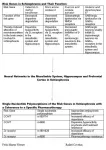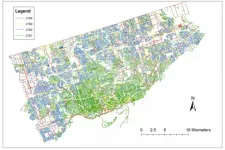Johns Hopkins develops drive-thru type test to detect viral infections in bacteria
2021-02-25
(Press-News.org) The pandemic has made clear the threat that some viruses pose to people. But viruses can also infect life-sustaining bacteria and a Johns Hopkins University-led team has developed a test to determine if bacteria are sick, similar to the one used to test humans for COVID-19.
"If there was a COVID-like pandemic occurring in important bacterial populations it would be difficult to tell, because before this study, we lacked the affordable and accurate tools necessary to study viral infections in uncultured bacterial populations," said study corresponding author Sarah Preheim, a Johns Hopkins assistant professor of environmental health and engineering.
The findings were published today in Nature Microbiology.
Sick bacteria are stymied in their function as decomposers and as part of the foundation of the food web in the Chesapeake Bay and other waterways. Determining viral infections in bacteria traditionally relies on culturing both bacteria and virus, which misses 99% of bacteria found in the environment because they cannot be grown in culture, Preheim says, adding that tests of viral infections in uncultured bacteria are expensive and difficult to apply widely, not unlike the early stages of COVID-19 testing.
The key to making a test of viral infections for uncultured bacteria faster and more affordable was to isolate single bacterial cells in a small bubble (i.e. an emulsion droplet) and fuse the genes of the virus and bacteria together once inside.
"The fused genes act like name tags for the bacteria and viruses," said lead author Eric Sakowski, a former postdoctoral researcher in Preheim's laboratory who is now an assistant professor at Mount St. Mary's University. "By fusing the genes together, we are able to identify which bacteria are infected, as well as the variant of the virus that is causing the infection."
The resulting test provides a novel way to screen for viral infections in a subset of bacterial populations. The test allows researchers to identify a link between environmental conditions and infections in Actinobacteria, one of the most abundant bacterial groups in the Chesapeake Bay and one that plays a crucial role in decomposing organic matter, making nutrients available to plants and photosynthetic algae.
Though the researchers developed this tool studying the Chesapeake Bay, they say their approach could be widely applied across aquatic ecosystems, shedding light on viral ecology and helping predict - and even prevent - devastating environmental impacts.
"This testing tool allows us to track viral infections more easily, so we can monitor these infections to see when they are most likely to have important environmental consequences," Preheim said.
Sakowski said the new test could someday also affect how we treat bacterial infections.
"Viruses show potential for treating infections caused by antibiotic-resistant bacteria," he said. "Knowing which viruses most effectively infect bacteria will be critical to this type of treatment."
INFORMATION:
Preheim's team also included Johns Hopkins doctoral student Keith Arora-Williams, and Funing Tian, Ahmed A. Zayed, Olivier Zablocki, and Matthew B. Sullivan, all from the Ohio State University.
ELSE PRESS RELEASES FROM THIS DATE:
2021-02-25
Bladder cancer is more aggressive and more advanced in South Texas residents than in many parts of the country, a study by the Mays Cancer Center, home to UT Health San Antonio MD Anderson, indicates.
The disease is also deadlier in Latinos and women, regardless of where they live nationwide, according to the research.
The team from The University of Texas Health Science Center at San Antonio (UT Health San Antonio), which includes the Mays Cancer Center, compared bladder cancer cases in the Texas Cancer Registry with cases in the Surveillance, Epidemiology and End Results (SEER) Program. SEER, which collects data on cancer cases from various locations and sources across the U.S., does not include Texas statistics.
Cases covered the years ...
2021-02-25
A Skoltech researcher has developed a theoretical model of wave formation in straits and channels that accounts for nonlinear effects in the presence of a coastline. This research can improve wave prediction, making maritime travel safer and protecting coastline infrastructure. The paper was published in the journal Ocean Dynamics.
Predicting surface weather at sea has always been a challenging task with very high stakes; for instance, over 4,000 people died due to rough seas during Operation Overlord at Normandy in June 1944, an allied incursion where poor forecasting altered the course of the operation quite significantly. Current wave forecasting models used, for example, by NOAA in the US, are imperfect, but they have many tunable parameters to ensure a reasonably good prediction.
However, ...
2021-02-25
Low blood levels of immune cells called lymphocytes, in combination with higher levels of inflammation on PET/CT scans, are indicators of active sarcoidosis -- an inflammatory disease that attacks multiple organs, particularly the lungs and lymph nodes -- which disproportionately affects African Americans. The discovery by researchers at the University of Illinois Chicago could help guide disease treatment. Their findings are published in the journal Frontiers in Medicine.
The researchers were looking for biomarkers -- both in the blood and in PET/CT scan findings -- ...
2021-02-25
Large carnivores are generally sensitive to ecosystem changes because their specialized diet and position at the top of the trophic pyramid is associated with small population sizes. This in turn leads to lower genetic diversity in top predators compared to animals lower down the food chain. Genetic diversity is very important for a species' ability to survive and adapt to future changes.
Extraordinary genetic diversity in an extraordinary cat
In this study, the researchers sequenced the complete genome of 53 African leopards and compared them to the Amur leopards and other big cat species. To their surprise, the researchers found that the genetic diversity of African leopards is extremely high: Almost four times ...
2021-02-25
Per- and polyfluoroalkyl substances (PFAS) are a class of man-made chemical compounds and a current, emerging concern to environmental health. PFAS substances have unique characteristics-resistance to heat, water, oil and stains-that make them useful in a variety of industrial applications and popular in consumer goods. Many PFAS are stable and long-lasting in the environment, acquiring the name "forever chemicals." Industrial use of some of these compounds has been halted; however, many derivatives are still in commerce and more are under development. PFAS are now found in many compartments of the environment.
In ...
2021-02-25
On January 14, 2021, the Department of Health and Human Services (HHS) submitted notice to the Federal Register that it would issue practice guidelines that exempt physicians from the requirement to apply for a waiver to prescribe buprenorphine to treat opioid use disorder (OUD) in up to 30 patients at one time. This exemption has been placed on hold by the Biden administration and may require legislative change to implement. An exemption to the X-waiver has the potential to help reverse the morbidity and mortality associated with the opioid overdose epidemic, although without accompanying changes and attention it will not be enough.
The combination of the COVID-19 pandemic and the opioid overdose epidemic fueled by high-potency synthetic ...
2021-02-25
Dr. Felix-Martin Werner, working at the Euro Academy Pößneck in Germany and Prof. Rafael Coveñas, working at the Institute of Neurosciences of Castilla and León, Salamanca in Spain, have been working on neurological and psychiatric disease for over ten years. In their most recent review, published in Current Pharmaceutical Design (Bentham Science Publishers) Werner and Coveñas cover information about the risk genes in schizophrenia and explain the importance of examining their single nucleotide polymorphisms (SNP's). In schizophrenia, 260 risk genes ...
2021-02-25
A computer network closely modelled on part of the human brain is enabling new insights into the way our brains process moving images - and explains some perplexing optical illusions.
By using decades' worth of data from human motion perception studies, researchers have trained an artificial neural network to estimate the speed and direction of image sequences.
The new system, called MotionNet, is designed to closely match the motion-processing structures inside a human brain. This has allowed the researchers to explore features of human visual processing that cannot be directly measured in the brain.
Their study, published in the Journal of Vision, uses the artificial system ...
2021-02-25
Over many decades now, traditional drug discovery methods have steadily improved at keeping diseases at bay and cancer in remission. And for the most part, it's worked well.
But it hasn't worked perfectly.
A lab on UNLV's campus has been a hub of activity in recent years, playing a significant role in a new realm of drug discovery -- one that could potentially provide a solution for patients who have run out of options.
"It's starting to get to the point where we've kind of taken traditional drug discovery as far as we can, and we really need something new," said UNLV biochemist Gary Kleiger.
Traditional drug discovery involves what is called the small molecule approach. To attack a protein that's causing disease in a cancer cell, for instance, ...
2021-02-25
With COVID-19 making it vital for people to keep their distance from one another, the city of Toronto undertook the largest one-year expansion of its cycling network in 2020, adding about 25 kilometres of temporary bikeways.
Yet, the benefits of helping people get around on two wheels go far beyond facilitating physical distancing, according to a recent study by three University of Toronto researchers that was published in the journal Transport Findings.
University of Toronto Engineering PhD candidate Bo Lin, as well as professors Shoshanna Saxe and Timothy Chan used ...
LAST 30 PRESS RELEASES:
[Press-News.org] Johns Hopkins develops drive-thru type test to detect viral infections in bacteria




